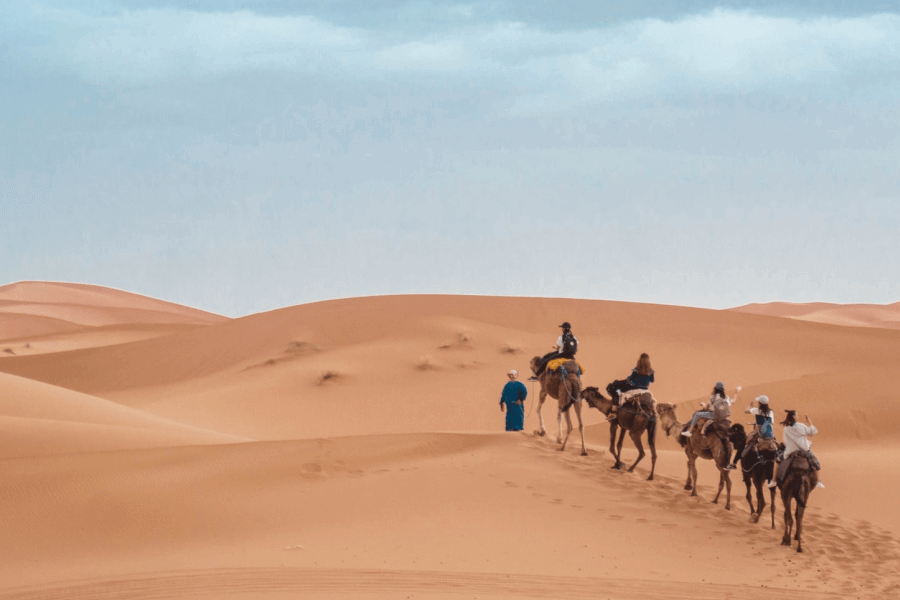Ancient People in Sahara
On Oct. 13, 2000, Paul Sereno, a professor from the University of Chicago, guided a team of palaeontologists to climb out of three broken Land Rovers, contented their water bottles and walked across the toffee-coloured desert called Tenere Desert. Tenere, one of the most barren areas on the Earth, is located on the southern flank of Sahara. According to the turbaned nomads Tuareg who have ruled this infertile domain for a few centuries, this California-size ocean of sand and rock is a ‘desert within a desert’. In the Tenere Desert, massive dunes might stretch a hundred miles, as far as the eyes can reach. In addition, 120-degree heat waves and inexorable winds can take almost all the water from a human body in less than a day.
Mike Hettwer, a photographer in the team, was attracted by the amazing scenes and walked to several dunes to take photos of the amazing landscape. When reaching the first slope of the dune, he was shocked by the fact that the dunes were scattered with many bones. He photographed these bones with his digital camera and went to the Land Rover in a hurry. ‘I found some bones,’ Hettwer said to other group members, ‘to my great surprise, they do not belong to the dinosaurs. They are human bones.’
One day in the spring of 2005, Paul Sereno got in touch with Elena Garcea, a prestigious archaeologist at the University of Cassino in Italy, asking her to return to the site with him together. After spending 30 years in researching the history of Nile in Sudan and of the mountains in the Libyan Desert, Garcea got well acquainted with the life of the ancient people in Sahara. But she did not know Sereno before this exploration, whose claim of having found so many skeletons in Tenere desert was unreliable to some archaeologists, among whom one person considered Sereno just as a ‘moonlighting palaeontologist’. However, Garcea was so obsessive with his perspective as to accept his invitation willingly.
In the following three weeks, Sereno and Garcea (along with five excavators, five Tuareg guides, and five soldiers from Niger’s army) sketched a detailed map of the destined site, which was dubbed Gobero after the Tuareg name for the area, a place the ancient Kiffian and Tuareg nomads used to roam. After that, they excavated eight tombs and found twenty pieces of artefacts for the above mentioned two civilisations. From these artefacts, it is evidently seen that Kiffian fishermen caught not only the small fish, but also some huge ones: the remains of Nile perch, a fierce fish weighing about 300 pounds, along with those of the alligators and hippos, were left in the vicinity of dunes.
Sereno went back with some essential bones and artefacts, and planned for the next trip to the Sahara area. Meanwhile, he pulled out the teeth of skeletons carefully and sent them to a researching laboratory for radiocarbon dating. The results indicated that while the smaller ‘sleeping’ bones might date back to 6,000 years ago (well within the Tenerian period), the bigger compactly tied artefacts were approximately 9,000 years old, just in the heyday of Kiffian era. The scientists now can distinguish one culture from the other.
In the fall of 2006, for the purpose of exhuming another 80 burials, these people had another trip to Gobero, taking more crew members and six extra scientists specializing in different areas. Even at the site, Chris Stojanowski, bio-archaeologist in Arizona State University, found some clues by matching the pieces. Judged from the bones, the Kiffian could be a people of peace and hardworking. ‘No injuries in heads or forearms indicate that they did not fight too much,’ he said. ‘And they had strong bodies.’ He pointed at a long narrow femur and continued, ‘From this muscle attachment, we could infer the huge leg muscles, which means this individual lived a strenuous lifestyle and ate much protein. Both of these two inferences coincide with the lifestyle of the people living on fishing.’ To create a striking contrast, he displayed a femur of a Tenerian male. This ridge was scarcely seen. ‘This individual had a less laborious lifestyle, which you might expect of the herder.’
Stojanowski concluded that the Tenerian were herders, which was consistent with the other scholars’ dominant view of the lifestyle in Sahara area 6,000 years ago, when the dry climate favoured herding rather than hunting. But Sereno proposed some confusing points: if the Tenerian was herders, where were the herds? Despite thousands of animal bones excavated in Gobero, only three cow skeletons were found, and none of goats or sheep found. ‘It is common for the herding people not to kill the cattle, particularly in a cemetery.’ Elena Garcea remarked, ‘Even the modem pastoralists such as Niger’s Wodaabe are reluctant to slaughter the animals in their herd.’ Sereno suggested, ‘Perhaps the Tenerian in Gobero were a transitional group that had still relied greatly on hunting and fishing and not adopted herding completely.’
 Dạng bài True False Not Given sẽ đi theo thứ tự
Dạng bài True False Not Given sẽ đi theo thứ tự Tuy nhiên, dò tìm xuyên suốt bài cũng ko thấy có đề cập đến từ khóa Green Sahara.
Tuy nhiên, dò tìm xuyên suốt bài cũng ko thấy có đề cập đến từ khóa Green Sahara.


